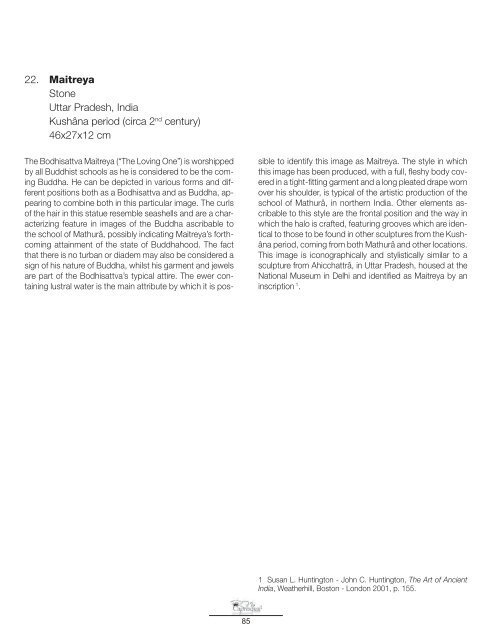Images of Devotion - capriaquar.it
Images of Devotion - capriaquar.it
Images of Devotion - capriaquar.it
Create successful ePaper yourself
Turn your PDF publications into a flip-book with our unique Google optimized e-Paper software.
22. Ma<strong>it</strong>reya<br />
Stone<br />
Uttar Pradesh, India<br />
Kushâna period (circa 2 nd century)<br />
46x27x12 cm<br />
The Bodhisattva Ma<strong>it</strong>reya (“The Loving One”) is worshipped<br />
by all Buddhist schools as he is considered to be the coming<br />
Buddha. He can be depicted in various forms and different<br />
pos<strong>it</strong>ions both as a Bodhisattva and as Buddha, appearing<br />
to combine both in this particular image. The curls<br />
<strong>of</strong> the hair in this statue resemble seashells and are a characterizing<br />
feature in images <strong>of</strong> the Buddha ascribable to<br />
the school <strong>of</strong> Mathurâ, possibly indicating Ma<strong>it</strong>reya’s forthcoming<br />
attainment <strong>of</strong> the state <strong>of</strong> Buddhahood. The fact<br />
that there is no turban or diadem may also be considered a<br />
sign <strong>of</strong> his nature <strong>of</strong> Buddha, whilst his garment and jewels<br />
are part <strong>of</strong> the Bodhisattva’s typical attire. The ewer containing<br />
lustral water is the main attribute by which <strong>it</strong> is pos-<br />
85<br />
sible to identify this image as Ma<strong>it</strong>reya. The style in which<br />
this image has been produced, w<strong>it</strong>h a full, fleshy body covered<br />
in a tight-f<strong>it</strong>ting garment and a long pleated drape worn<br />
over his shoulder, is typical <strong>of</strong> the artistic production <strong>of</strong> the<br />
school <strong>of</strong> Mathurâ, in northern India. Other elements ascribable<br />
to this style are the frontal pos<strong>it</strong>ion and the way in<br />
which the halo is crafted, featuring grooves which are identical<br />
to those to be found in other sculptures from the Kushâna<br />
period, coming from both Mathurâ and other locations.<br />
This image is iconographically and stylistically similar to a<br />
sculpture from Ahicchattrâ, in Uttar Pradesh, housed at the<br />
National Museum in Delhi and identified as Ma<strong>it</strong>reya by an<br />
inscription 1 .<br />
1 Susan L. Huntington - John C. Huntington, The Art <strong>of</strong> Ancient<br />
India, Weatherhill, Boston - London 2001, p. 155.


